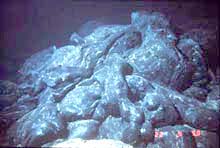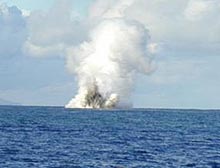
Submarine eruptions at mid-ocean ridges produce fresh lava flows like these “pillow” lavas, that form as lava slowly oozes out of a fissure on the seafloor. Click image for larger view and more information.
Submarine Volcanism
The Ring of Fire
Bill Chadwick
Volcanologist
Oregon State University
The “Ring of Fire” is a circular arc of active volcanoes that surrounds the Pacific Ocean basin. Much is known about the volcanoes on land within the Ring of Fire (e.g., in the Aleutians, the Cascades, the Andes, etc.), but little is known about the submarine volcanoes, simply because they are underwater and more difficult to observe. This multi-year project aims to explore submarine volcanoes within the Ring of Fire in two very different tectonic settings on either side of the Pacific: one in which new seafloor is created and the other in which old seafloor is destroyed.
Volcanoes and Plate Tectonics
The Earth is covered with “tectonic plates” that are in constant motion over the partially molten interior. Almost all the volcanoes on Earth occur where tectonic plates are either moving apart or are moving together. Where tectonic plates are moving apart, molten rock or “magma” rises up from deep within the Earth to fill the gap, and in doing so, creates new ocean floor. The boundaries between separating plates are called “spreading centers” or “mid-ocean ridges.” They are the sites of frequent submarine volcanic eruptions. Explorer Ridge in the northeast Pacific is an example of a mid-ocean ridge and will be the focus of our exploration during the first year of this project.
Where tectonic plates are colliding, one plate is usually forced under the other in a process called “subduction.” At subduction zones, the plate that is forced downward dives back into the Earth and is eventually melted and recycled. This process also causes melting above subduction zones. This molten rock rises back up to the surface to feed chains of active volcanoes called “volcanic arcs.” Volcanic arcs can be on land or underwater, or can be a combination of islands and submarine volcanoes. The Marianas Arc in the western Pacific is an example of a volcanic arc with many volcanic islands and underwater volcanoes. It will be the focus of this project in future years.

In contrast to the relatively gentle eruption of basaltic submarine volcanoes, island arc volcanoes often erupt lavas with a higher silica content and more dissolved gases. Photo courtesy of Australian Commonwealth Scientific and Industrial Corporation. Click image for larger view and more information.
Volcanoes in these two different settings have very different characteristics. Mid-ocean ridge volcanoes tend to be linear, and resemble long low ridges. Arc volcanoes are cone-shaped, centralized and isolated. Mid-ocean ridge volcanoes also have more primitive lava compositions because the lava comes more or less directly from the Earth's interior without changing much. On the other hand, the lava that reaches arc volcanoes rises through a longer path from its source region to the surface. Thus, its composition can be significantly changed along the way. This difference in compositions is reflected in the fact that mid-ocean ridge eruptions are generally non-explosive, whereas arc eruptions often are explosive.
Volcanoes, Hydrothermal Vents, and Life
Where submarine volcanoes bring hot magma near the seafloor or erupt lava at the surface, seafloor hot springs called “hydrothermal vents” are common. Seawater that circulates deep within a submarine volcano gets heated up before it returns to the seafloor. Hydrothermal vent fluid is rich in dissolved chemicals. These hot springs support a unique ecosystem of microorganisms and animals that is independent of sunlight. Biotech companies are particularly interested in the heat-tolerant microbes that live on and below the seafloor at submarine volcanoes because they have novel enzymes that may be useful for creating new medicines. Because the DNA of organisms living at seafloor hot springs is very primitive, some scientists believe that life on Earth may have originated at deep sea hydrothermal vents on submarine volcanoes.
Sign up for the Ocean Explorer E-mail Update List.






















